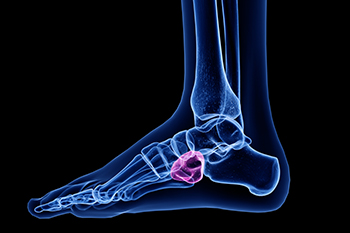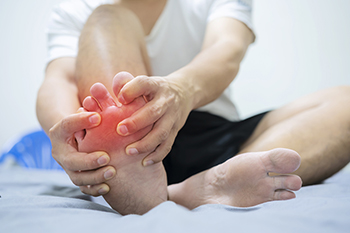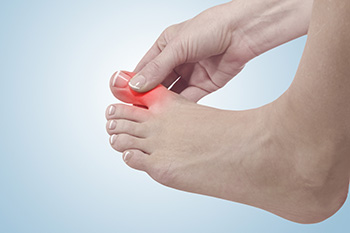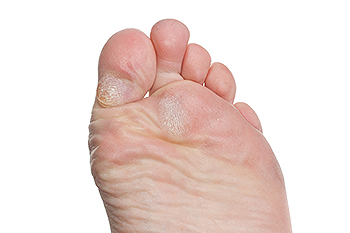3885 S. Decatur Blvd Suite #1080
Las Vegas, NV 89103

Cuboid syndrome is a condition that involves a disruption of the normal alignment of the cuboid bone with the heel bone, and it causes pain on the outside of the foot. The pain might feel like it originates from the outside of the ankle, and the person afflicted with it may limp or sway when walking to avoid placing weight on the affected area. Mild swelling or bruising might be seen on the outside and bottom of the mid-foot. This problem develop from a single event, such as an ankle sprain, or through repetitive impact to the area, like runners or dancers (particularly ballet dancers) might experience. A small “popping” might be felt on the outside of the mid-foot as well. Treatment of cuboid syndrome usually involves making sure shoes are well-fitting and comfortable, using soft orthotics, and doing stretching exercises to help mobilize the joint. In some instances, realignment of the cuboid bone is needed. If you feel pain in your mid-foot area and it is worsening, you might have a more severe case of cuboid syndrome. You can see a podiatrist who can properly diagnose the problem and provide appropriate treatment.
Cuboid syndrome, also known as cuboid subluxation, occurs when the joints and ligaments near the cuboid bone in the foot become torn. If you have cuboid syndrome, consult with Loren Hansen, DPM from Ankle & Foot Medical Center. Our doctor will assess your condition and provide you with quality foot and ankle treatment.
Cuboid syndrome is a common cause of lateral foot pain, which is pain on the outside of the foot. The condition may happen suddenly due to an ankle sprain, or it may develop slowly overtime from repetitive tension through the bone and surrounding structures.
Causes
The most common causes of cuboid syndrome include:
Symptoms
A common symptom of cuboid syndrome is pain along the outside of the foot which can be felt in the ankle and toes. This pain may create walking difficulties and may cause those with the condition to walk with a limp.
Diagnosis
Diagnosis of cuboid syndrome is often difficult, and it is often misdiagnosed. X-rays, MRIs and CT scans often fail to properly show the cuboid subluxation. Although there isn’t a specific test used to diagnose cuboid syndrome, your podiatrist will usually check if pain is felt while pressing firmly on the cuboid bone of your foot.
Treatment
Just as the range of causes varies widely, so do treatments. Some more common treatments are ice therapy, rest, exercise, taping, and orthotics.
If you have any questions, please feel free to contact our office located in Las Vegas, NV . We offer the newest diagnostic and treatment technologies for all your foot care needs.

The pain from a severe gout attack can be debilitating. Many patients find it difficult to walk, and even the weight of a bed sheet can be disturbing. Gout is a type of arthritis that is brought on by an excess amount of uric acid in the blood. This converts to crystals, and can lodge in the joints of the big toe. Gout can develop from genetic reasons, leading a sedentary lifestyle, or from eating foods that are not healthy. These include an excess of red meat, shellfish or alcohol, or from having drinks that are made with large amounts of sugar. There may also be existing medical conditions that can lead to gout. Among these are obesity, high blood pressure, diabetes, or kidney damage. A proper diagnosis of gout involves having a blood sample drawn that can determine the uric acid level. In severe cases, there may be a needle inserted into the affected joint, and an analysis of the fluid. Relief may be found when the foot is elevated, and this may help to diminish a portion of the swelling that often accompanies gout. If you have gout attacks, it is strongly advised that you are under the care of a podiatrist who can properly diagnose and treat this condition.
Gout is a painful condition that can be treated. If you are seeking treatment, contact Loren Hansen, DPM from Ankle & Foot Medical Center. Our doctor will treat your foot and ankle needs.
What Is Gout?
Gout is a form of arthritis that is characterized by sudden, severe attacks of pain, redness, and tenderness in the joints. The condition usually affects the joint at the base of the big toe. A gout attack can occur at any random time, such as the middle of the night while you are asleep.
Symptoms
Risk Factors
Prior to visiting your podiatrist to receive treatment for gout, there are a few things you should do beforehand. If you have gout you should write down your symptoms--including when they started and how often you experience them, important medical information you may have, and any questions you may have. Writing down these three things will help your podiatrist in assessing your specific situation so that he or she may provide the best route of treatment for you.
If you have any questions, please feel free to contact our office located in Las Vegas, NV . We offer the newest diagnostic and treatment technologies for all your foot care needs.

Big toe pain can be caused by a variety of different things – some requiring medical interventions and some not. Causes of toe pain include an injury, such as a fracture or turf toe, or an underlying medical condition like arthritis (osteoarthritis, rheumatoid, or gout). Other reasons are an ingrown toenail, sesamoiditis, a bunion, a nail infection, or Morton’s neuroma. If one is suffering from pain in their big toe, resting the foot, elevating it, icing the toe, and wearing firmer soled shoes may help. However, to properly determine the underlying cause of your big toe pain, or when your pain is unexplained or sudden, see a podiatrist who can diagnose the problem and offer treatment options.
Toe pain can disrupt your daily activities. If you have any concerns, contact Loren Hansen, DPM of Ankle & Foot Medical Center. Our doctor can provide the care you need to keep you pain-free and on your feet.
What Causes Toe Pain?
Most severe toe pain is caused due to a sports injury, trauma from dropping something heavy on the toe, or bumping into something rigid. Other problems can develop over time for various reasons.
Toe pain can be caused by one or more ailments. The most common include:
When to See a Podiatrist
Diagnosis
In many cases the cause of toe pain is obvious, but in others, a podiatrist may want to use more advanced methods to determine the problem. These can range from simple visual inspections and sensation tests to X-rays and MRI scans. Prior medical history, family medical history, and any recent physical traumatic events will all be taken into consideration for a proper diagnosis.
Treatment
Treatments for toe pain and injuries vary and may include shoe inserts, padding, taping, medicines, injections, and in some cases, surgery. If you believe that you have broken a toe, please see a podiatrist as soon as possible.
If you have any questions please feel free to contact our office located in Las Vegas, NV . We offer the newest diagnostic tools and technology to treat your foot and ankle needs.

Calluses form when the skin is trying to protect itself from damage. A hardened layer of skin develops when friction combines with pressure in reaction to a tight shoe, for instance. Sometimes a callus will form because of a bunion or other bone malformation that changes the way you walk. There are three types of calluses: hard, soft, and vascular or neurovascular. A hard callus, the most common type and easiest to recognize, is usually compact. A soft callus, generally found between the toes, has a more rubbery consistency. A vascular callus contains blood vessels, and the neurovascular type has nerve tissue, which can become painful. The most effective way to avoid unsightly hard calluses on the foot or heel is to choose well-fitting, comfortable, flat footwear. Sometimes, special orthotics may be needed. Using a pumice can help reduce the size of a callus, but for safer removal it may be wise to seek the help of a podiatrist.
Everyday foot care is very important to prevent infection and other foot ailments. If you need your feet checked, contact Loren Hansen, DPM from Ankle & Foot Medical Center. Our doctor can provide the care you need to keep you pain-free and on your feet.
Everyday Foot Care
Often, people take care of their bodies, face and hair more so than they do for their feet. But the feet are a very important aspect of our bodies, and one that we should pay more attention to. Without our feet, we would not be able to perform most daily tasks.
It is best to check your feet regularly to make sure there are no new bruises or cuts that you may not have noticed before. For dry feet, moisturizer can easily be a remedy and can be applied as often as necessary to the affected areas. Wearing shoes that fit well can also help you maintain good foot health, as well as making it easier to walk and do daily activities without the stress or pain of ill-fitting shoes, high heels, or even flip flops. Wearing clean socks with closed shoes is important to ensure that sweat and bacteria do not accumulate within the shoe. Clean socks help to prevent Athlete’s foot, fungi problems, bad odors, and can absorb sweat.
If you have any questions please feel free to contact our office located in Las Vegas, NV . We offer the newest diagnostic and treatment technologies for all your foot and ankle needs.